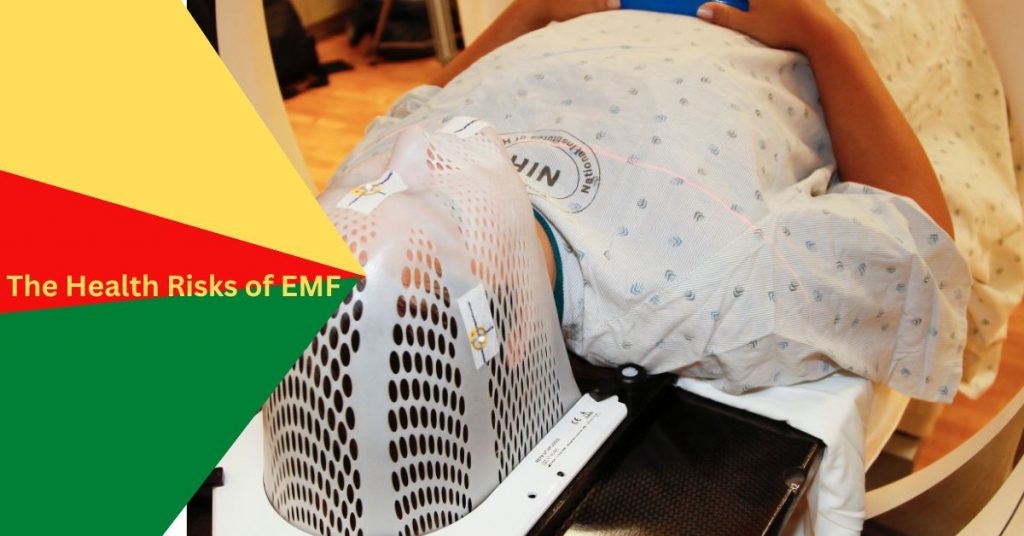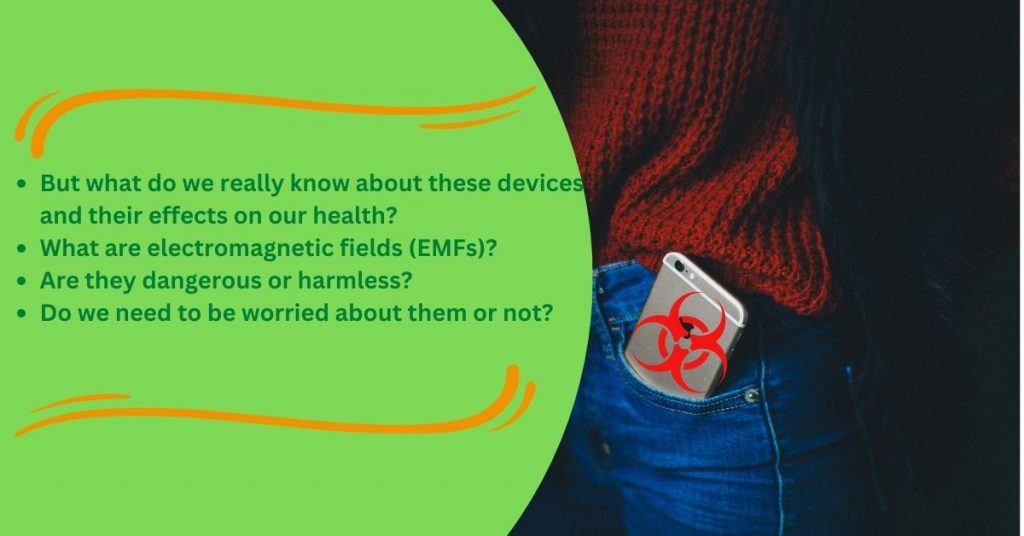
You all can attest that electronic conveniences in our lives have increased dramatically over recent years. Cell phones, computers, and other devices are no longer just a luxury but also a necessity in today’s world.
- But what do we really know about these devices and their effects on our health?
- What are electromagnetic fields (EMFs)?
- Are they dangerous or harmless?
- Do we need to be worried about them or not?
Well, this article seeks to shed light on everything you need to know about electric and magnetic fields.
What is EMF?
An electromagnetic field (EMF) refers to an area of energy produced by electrically charged objects. It exists around anything with an electrical charge, such as atoms, molecules, and subatomic particles.
The Earth itself has an overall magnetic field produced by electrical currents within its core, which acts as a shield against harmful cosmic rays from outer space.
In addition to natural sources of EMFs, many man-made sources can be found in our daily lives. They include power lines and household appliances in our homes, cell phones and towers, computers and televisions, microwave ovens, baby monitors, and more.
Types of EMFs
There are two types of electromagnetic fields: ionizing radiation and non-ionizing radiation.
Ionizing radiation
Ionizing radiation refers to high-energy waves, including X-rays and UV rays. They have enough energy to remove electrons from atoms, turning them into ions. These ionized particles have an electric charge that makes them hazardous to living cells in our bodies which affects human health. The most common sources of ionizing radiation include natural phenomena such as cosmic rays, solar flares, and man-made objects such as nuclear reactors.
Non-ionizing radiation
Non-ionizing radiation does not have enough energy to strip electrons from their orbits around atoms or molecules. It includes radio frequency electromagnetic fields, microwaves, infrared light, visible light, and more. Sources of non-ionizing radiation include televisions and computer screens, cell phones and towers, power lines, microwaves, and more.
Sources of EMFs in daily life
Depending on where you live and work, you’re exposed to varying levels of electromagnetic field (EMF) radiation from various sources, including but not limited to electronic devices. Here are some things that may be producing unwanted EMFs in your life:
Power lines
Power lines are a major source of electromagnetic field (EMF) radiation. If you live in an urban area, there’s a good chance you’re exposed to some level of EMFs from power lines on a daily basis. Most people don’t even realize it because most homes have wiring that’s been built into walls and floors, which shields them from direct exposure.
However, if you work or play near high-voltage power lines, your risk goes up significantly. And if you live near or under one—your risk is even greater. Thankfully, transformers reduce EMFs for those who live or work near power lines. They do so by reducing voltage and converting it from AC to DC to save human health (and vice versa). This reduces EMF levels in surrounding areas by as much as 90% to improve human health.
Televisions and computer screens
Televisions and computer screens are some of the worst offenders when it comes to emitting electromagnetic field (EMF) radiation. Unfortunately, they’re also in most homes—so avoiding exposure altogether isn’t possible. If you can, try to keep televisions at least a few feet away from your body at all times—and try not to spend too much time looking at them. A rule of thumb to consider, the size of the screen of your device in inches, is the minimum amount of space you should hold in between your body and the electronic device to limit emf exposure.
Normally, modern TVs employ LED, LCD, or plasma screens that emit lower levels of EMFs than older models. But if you have an old CRT television set in your home, that could be putting out more than 100 milligauss—which is 10x higher than what’s considered safe.
A rule For those using a computer for work or school, consider using an EMF protection shield so that your head doesn’t have direct contact with the screen. These shields reduce radiation by as much as 95%. They’re especially effective for pregnant women and young children who may be more sensitive to these types of fields.
Wireless devices
The electromagnetic field (EMF) radiation that comes from wireless devices, such as cellular phones and cordless phones, has been a hot topic of debate in recent years. And for a good reason—some scientific evidence suggests wireless devices may be linked to certain types of cancers, including brain cancer. The environmental health sciences institute has found correlations between EMF radiation and cancers, especially childhood leukemia and chronic lymphocytic leukemia. However, more research needs to be done before we can definitively say that there’s a link between wireless devices and cancer. Regardless, it’s probably wise to limit your use of wireless devices whenever possible. If you must use one regularly, try to keep it at least an arm’s length away from your body or (use the screen size rule of thumb listed above)—and try not to put it directly against your head or torso.
Microwaves
People use microwaves to heat food and beverages all day long. However, these devices produce electromagnetic field (EMF) radiation that’s similar to what comes from cell phones and cordless phones. As such, you should avoid using them whenever possible. If you need to use a microwave, try not to stand directly in front of it while it’s on—and keep your distance from it as much as possible. Also, try not to let children play with or near microwaves when they’re turned on.
The Health Risks of EMF

Ionizing
Ionizing EMF can be detrimental since it breaks chemical bonds and changes the chemical and molecular structures of different substances, including human tissues. It has been linked with cancer as well as neurological disorders. Basically, the damage occurs when ionizing radiation passes through a living cell or tissue by transferring its energy to molecules that are present in our bodies. The type of radiation that causes ionization is X-rays, gamma rays, and alpha particles. They all carry high levels of energy which makes them harmful to living things but also very useful for medical purposes such as imaging procedures (e.g., X-rays) or treating certain types of cancers (e.g., radiation therapy) according to the national cancer institute.
Non-ionizing
Non-ionizing EMFs may still pose health risks since they have enough energy to heat up body tissue which could result in burns and/or cellular destruction if exposed for long periods of time. However, scientific research indicates that non-ionizing radiation does not cause any significant damage because it doesn’t have enough energy to break chemical bonds or alter molecular structures. Other research has raised concerns about mobile phones and cancer risk, but studies suggest no link between these two factors.
In response to electric and magnetic fields exposure the World Health Organization has started a chartered project to assess EMF exposure from extremely low frequency EMFs of 0 GHz to high frequency EMF exposure of 300 GHz since 1996. In a survey provided by the World Health Organization to find correlations in environmental health sciences of different countries on how they are handling EMFs radiation they found over 80% of countries have legislation to limit electromagnetic field exposure to avoid adverse health effects to public health.
The National Institute of Environmental Health Sciences concluded in the EMF-RAPID programme published in 1999 that EMF exposure is not safe due to its association with leukemia, but due to insufficient evidence it does not warrant aggressive regulation. However, the National Institute of Environmental Health Sciences did advise that public health agencies should emphasize possible health risks associated with EMF exposure through education and occupational safety.
Electric and Magnetic fields Safety Precautions

Limit the use of mobile phones
Cell phones emit radiofrequency radiation energy, a form of non-ionizing electromagnetic radiation, which has been linked to increased risk of cancer. While no human studies have shown increased cancer risk with cellular phone use, current research suggests there may be a link between cellular phone use and certain types of brain tumors. Further research is needed before we know if using your mobile phone causes health effects. The best advice, for now, is to limit your cell phone use or keep it away from your body when it’s not used for calling or texting.
Text instead of calling
Texting uses a little signal to transmit data, so it produces less RF energy than a call. Plus, you’re not exposed to as much radiation when you’re typing on your phone as you are when talking. If you must make a call or send a text, try to keep your phone away from your body while doing so. Your safest bet: use a speakerphone or headphones during calls and texts instead of holding your phone directly against your ear.
Use strong cell phone reception
The more cell phone towers you pass while you’re talking on your phone, the more RF energy your body absorbs. To limit your exposure, keep calls short and try not to stand directly underneath a cell tower. If possible, use a corded or cordless phone instead of making a call on your mobile phone.
Protect yourself during sun exposure
The sun emits UV radiation, which has also been linked to cancer. When you’re outside on a bright day, be sure to use sunscreen with an SPF of 15 or higher and limit your time in direct sunlight as much as possible. The sun can even damage your eyes—ensure you wear sunglasses that offer 100% UVA and UVB protection outdoors.
Ask for a pat-down at airport security
The Transportation Security Administration (TSA) uses ionizing radiation to screen passengers for weapons and other prohibited items. The amount of radiation you receive depends on your proximity to a scanner, but it can still lead to increased exposure and health risks. If you prefer not to be scanned, you have options: a pat-down or an enhanced pat-down. This refers to a physical search in which officers will touch all parts of your body. While many people feel uncomfortable with these searches, there are no known long-term health effects from being patted down.
Avoid unnecessary X-rays
X-rays are another form of ionizing radiation that can damage cells in your body when exposed to too much over time—even if you don’t feel any symptoms right away. When possible, ask your doctor to use a different imaging method (such as ultrasound or MRI) during medical procedures. If you need an X-ray, try to minimize your exposure by staying as far from the machine as possible and keeping lead vests on both yourself and your child at all times.
To reduce ionizing EMFs radiation adverse health effects in the body vitamin C has been found to be an antioxidant that is water soluble and with no known potential health risks with taking 500 IU of Vitamin C or more. Vitamin C reduces those free radicals from ionizing EMFs to limit tissue damage or potential health risks.
Frequently Asked Questions About electromagnetic field (EMF)
Is electromagnetic field (EMF) harmful to our health?
There is not enough evidence that the electromagnetic field (EMF) is harmful to our health. However, there are some concerns regarding its safety. Some people believe that exposure to electromagnetic fields could be linked with cancer, Alzheimer’s disease, and other neurological disorders. Others have reported experiencing headaches and dizziness after prolonged exposure to sources of EMFs such as cell phones and power lines.
Does EMF mess with your brain?
It is believed that RF-EMF causes Neurological, cognitive disorders, including tremors, loss of memory, headache, dizziness, and fatigue. However, there is not enough evidence proving that the electromagnetic field (EMF) does affect our brains. Some researchers also believe that the electromagnetic field (EMF) could cause cancer in humans as it has been linked with cancer in animals.
However, there are many factors other than exposure to electromagnetic fields which could increase your risk of cancer, such as genetics or lifestyle choices. Therefore, more research needs to be conducted before we can make any conclusions regarding its safety in our health.
Can you feel EMF waves?
No. Most electromagnetic fields (EMFs) are invisible and cannot be felt by our senses. However, some people say that they can feel their presence or that their skin is sensitive to them. This phenomenon is called electromagnetic hypersensitivity.
What EMF feels like?
People that believe they are sensitive to EMFs describe feeling similar symptoms such as dizziness, nausea, and migraines. Most of them also report that their condition appears with exposure to power lines or any electronic equipment that produces electromagnetic waves. However, there has not been enough evidence proving that the electromagnetic field (EMF) causes these health problems. Therefore, it could be a psychological problem rather than an actual sensitivity.
What is the harmful level of EMF?
The high-frequency EMF of up to 70 mv/m can cause health problems. It could be harmful if you are exposed to them for a long time. Such high-frequency EMFs include power lines and Wi-Fi signals. The rule of thumb is to avoid such sources of electromagnetic fields (EMFs) when possible.
What sources produce EMF?
Sources of electromagnetic fields (EMFs) in daily life include mobile phones, computers, microwaves, televisions, cordless phones, and baby monitors, as well as electric blankets, hair dryers, and electric shavers.
Conclusion
EMF radiation has been linked to several health issues. While many of these are still being researched, it’s essential that we take steps to limit our exposure as much as possible. This can be done by reducing our use of cell phones and other devices that emit high levels of EMFs, using wired devices whenever possible, and purchasing products with low levels of radiation.
It’s also recommended that children avoid using mobile phones as much as possible to reduce their risk of developing cancer later in life. Hopefully, this article has given you all you need to know about what EMFs are, how they affect us, and how we can minimize them.





